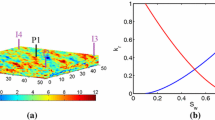Abstract.
Geostatistical simulation algorithms are routinely used to generate conditional realizations of the spatial distribution of petrophysical properties, which are then fed into complex transfer functions, e.g. a flow simulator, to yield a distribution of responses, such as the time to recover a given proportion of the oil. This latter distribution, often referred to as the space of uncertainty, cannot be defined analytically because of the complexity (non-linearity) of transfer functions, but it can be characterized algorithmically through the generation of many realizations. This paper compares the space of uncertainty generated by four of the most commonly used algorithms: sequential Gaussian simulation, sequential indicator simulation, p-field simulation and simulated annealing. Conditional to 80 sample permeability values randomly drawn from an exhaustive 40×40 image, 100 realizations of the spatial distribution of permeability values are generated using each algorithm and fed into a pressure solver and a flow simulator. Principal component analysis is used to display the sets of realizations into the joint space of uncertainty of the response variables (effective permeability, times to reach 5% and 95% water cuts and to recover 10% and 50% of the oil). The attenuation of ergodic fluctuations through a rank-preserving transform of permeability values reduces substantially the extent of the space of uncertainty for sequential indicator simulation and p-field simulation, while improving the prediction of the response variable by the mean of the output distribution. Differences between simulation algorithms are the most pronounced for long-term responses (95% water cut and 50% oil recovery), with sequential Gaussian simulation yielding the most accurate prediction. In this example, utilizing more than 20 realizations generally increases only slightly the size of the space of uncertainty.
Similar content being viewed by others
Author information
Authors and Affiliations
Rights and permissions
About this article
Cite this article
Goovaerts, P. Impact of the simulation algorithm, magnitude of ergodic fluctuations and number of realizations on the spaces of uncertainty of flow properties. Stochastic Environmental Research and Risk Assessment 13, 161–182 (1999). https://doi.org/10.1007/s004770050037
Issue Date:
DOI: https://doi.org/10.1007/s004770050037




